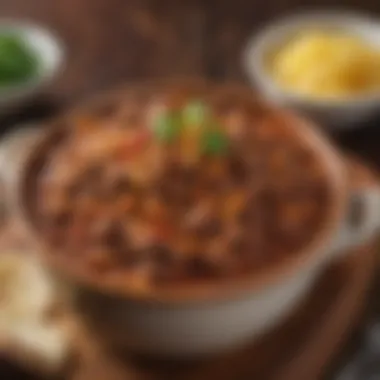Delicious Easy Crock Pot Ground Beef Recipes


Intro
Recipe Overview
Using a slow cooker simplifies the cooking process while allowing flavors to develop over time. Each recipe showcased here emphasizes straightforward techniques and essential ingredients, demonstrating the flexibility of ground beef in a subtle manner.
Brief Description of the Dish
Crock pot meals featuring ground beef can range from hearty stews and casseroles to comforting chili and meatballs. These dishes typically require minimal active cooking time, enabling you to prepare other aspects of your day while your meal cooks slowly in the pot.
Ingredients List
When preparing ground beef recipes, certain ingredients are common across various dishes:
- Ground beef (preferably lean or extra-lean)
- Onion (chopped)
- Garlic (minced)
- Bell peppers (diced)
- Canned tomatoes (diced or crushed)
- Beans (e.g., kidney or black beans)
- Broth or stock (beef or vegetable)
- Seasonings (e.g., salt, black pepper, cumin, chili powder)
- Optional: cheese, herbs, or spices for garnish
Step-by-Step Cooking Instructions
Following a systematic process when using a crock pot can maximize flavor and efficiency. Below is a general guide that can apply to most ground beef recipes:
- Prepare the Ingredients
Start by chopping all vegetables and measuring out canned ingredients. This prep step saves time later on. - Brown the Ground Beef
Although this step can be skipped, browning the ground beef in a skillet first enhances the flavor and texture. Cook until browned, then drain excess fat before transferring it to the crock pot. - Combine Ingredients
In the crock pot, layer the browned beef with your chopped vegetables and canned ingredients. Stir gently to combine. - Add Seasonings and Liquids
Pour in any broth or additional liquid. Sprinkle the seasonings evenly over the top. The proportions can vary by taste, so adjust accordingly. - Set the Cooker
Close the lid and set the crock pot on low for 6-8 hours or high for 3-4 hours. - Final Adjustments
About 30 minutes before serving, taste the dish and adjust seasonings if necessary. You can also add cheese or herbs for extra flavor at this point.
Useful Tips for Each Step
- Browning is optional, but recommended for depth of flavor.
- Ensure the lid fits tightly to maintain moisture and temperature.
- Consider adding vegetables like potatoes or carrots for more substance.
Follow this framework for a variety of ground beef recipes, and feel free to experiment with your own variations to suit your taste preferences. Remember, the beauty of cooking with a crock pot is the opportunity to let the flavors meld together over time.
Foreword to Crock Pot Cooking
Crock pot cooking is a culinary method that is often underappreciated, yet it offers significant advantages to both novice and seasoned cooks. The slow cooker, or crock pot, has gained popularity due to its ability to produce flavorful meals with minimal effort. This section will highlight the importance of understanding crock pot cooking.
Understanding the Crock Pot
A crock pot is an electric cooking appliance that simmers food at a low temperature over an extended period. This method preserves the natural flavors and nutrients of the ingredients. A typical crock pot consists of a ceramic pot, a heating element, and a lid.
How it works is quite simple. You place the ingredients in the pot, set the temperature, and let time do its magic. The low and steady heat allows for even cooking without the need for frequent monitoring.
When it comes to compatibility, most recipes that use traditional cooking methods can be adapted for a crock pot. However, it is essential to consider the quantity of liquid and the texture of the ingredients since too much liquid can result in a watery dish.
Advantages of Slow Cooking
There are several advantages to using a crock pot for meal preparation. Firstly, it saves time. You can prepare your ingredients in the morning, turn on the crock pot, and return to a delicious meal ready to serve. This feature appeals greatly to busy individuals and families.
Benefits of slow cooking include:
- Flavor Development: Slow cooking allows flavors to meld together beautifully. Ingredients have the time to release their natural flavors, resulting in a richer taste.
- Tender Meats: The low temperature breaks down tough cuts of meat, making them tender and juicy without the need for constant attention.
- Energy Efficiency: Using a small appliance like a crock pot uses less energy compared to heating an entire oven.
- Versatility: Whether you’re cooking soups, stews, or even desserts, a crock pot can handle it all. You can easily adapt a variety of meals to this cooking style.
The Role of Ground Beef in Recipes
Ground beef is a versatile ingredient in many kitchens. It holds a central position in a variety of recipes, particularly in crock pot cooking. The ease of preparation, coupled with its rich flavor, makes it a popular choice. When cooked slowly, ground beef blends well with other ingredients, enhancing their taste while providing a satisfying texture.
Nutritional Aspects of Ground Beef
Ground beef is a significant source of protein, making it an essential component of many diets. A standard serving contains a good amount of iron, zinc, and B vitamins. These nutrients are important for your overall health. The protein content helps in muscle building and repair. However, keep in mind that ground beef can also be high in fat, depending on the cut of meat used. Choosing leaner options can provide the benefits of protein without excessive calories from fat. Thus, understanding nutritional value helps in selecting the right type of ground beef for your meals.
Ground Beef Varieties
Ground beef comes in several varieties, and knowing these can help in making informed choices for recipes.
Lean vs. Fatty Ground Beef
Lean ground beef typically contains less fat than its fatty counterpart. The key characteristic of lean ground beef is its lower calorie content. This makes it a beneficial choice for those monitoring their fat intake. On the other hand, fatty ground beef provides more flavor due to its higher fat content. For instance, an 80/20 mix (80% lean and 20% fat) is often used in recipes where moisture and flavor are paramount. When deciding between lean or fatty ground beef, consider the flavor profile desired and the health aspects you want to focus on in your meal preparation.


Grass-Fed vs. Grain-Fed
Grass-fed beef is receiving attention for its potential health benefits. The key characteristic of grass-fed ground beef is that the cattle have been fed a natural diet of grass, which can result in a better nutrient profile. Grass-fed options tend to have higher omega-3 fatty acids and vitamins compared to grain-fed beef. However, grass-fed beef is often pricier and may not be as widely available. Grain-fed beef, while generally more affordable, may lack some of the nutrients found in grass-fed varieties. When selecting beef for crock pot recipes, weighing these differences can help you align your dietary goals with taste preferences.
"The choice of ground beef can significantly impact both nutritional value and flavor in your crock pot recipes."
Essential Ingredients for Success
The success of any meal, particularly in slow cooking with a crock pot, hinges on the choice of ingredients. Utilizing the right components ensures that the final dish is not only flavorful but also satisfying. Ingredients like spices, seasonings, and vegetables play pivotal roles in enhancing the taste of ground beef recipes. By carefully selecting these ingredients, you can achieve a wealth of flavors, transforming basic dishes into culinary delights. Moreover, understanding the significance of these ingredients is crucial. It helps home cooks tailor their meals to personal preferences and dietary needs, making slow cooking an adaptable method for everyone.
Spices and Seasonings
Spices and seasonings are the backbone of any flavorful dish. They are essential, especially when cooking with ground beef in a crock pot. Basic seasonings like salt and pepper provide a foundation, but adding herbs like oregano, cumin, and paprika can elevate the meal entirely. Each spice contributes unique characteristics, bringing out the natural flavors of the beef while also introducing new layers of complexity.
When using spices, timing is key.
- Adding certain spices at the beginning of cooking can infuse the beef with deep flavors.
- Others, like fresh herbs, should be added later to preserve their vibrancy.
- Some spices, such as bay leaves or whole peppercorns, may need to be removed before serving.
One helpful tip is to experiment with spice blends. For example, a taco seasoning mix can work wonders for ground beef tacos, whereas Italian seasoning may be perfect for a crock pot lasagna. This can simplify the cooking process while also ensuring the dish is packed with flavor.
Vegetable Pairings
Vegetable pairings are another crucial element in creating a successful crock pot ground beef recipe. The texture and flavor of vegetables not only complement the beef but also add important nutrients. Choosing the right vegetables can make a significant difference in the dish's overall profile.
Some classic pairings include:
- Onions: They add sweetness and depth when slow-cooked.
- Bell Peppers: Their crunchiness balances the meat's richness.
- Carrots: They enhance the dish with sweetness and color.
When selecting vegetables, consider both cooking time and texture. Some vegetables, like potatoes, require longer cooking times, while others, such as spinach, wilt quickly. A typical approach is to layer harder vegetables at the bottom of the crock pot, followed by ground beef and then softer vegetables on top. This method ensures even cooking and prevents overcooking soft vegetables.
Ultimately, the combination of spices and vegetable pairings can define the success of your crock pot meals. The right ingredients lead to delicious outcomes, making each recipe special and memorable.
Classic Chili with Ground Beef
Ingredients Required
The ingredients for classic chili are foundational to its rich, hearty flavor. The primary component here is ground beef, which should ideally be lean to prevent excessive grease. Key ingredients include:
- Ground beef (preferably 80/20 for a nice balance of flavor and lean meat)
- Beans: kidney and black beans enhance texture and nutrition
- Tomatoes: canned diced tomatoes provide acidity and depth
- Spices: chili powder, cumin, and garlic powder contribute to the flavor profile.
These ingredients are beneficial because they complement each other well, creating a robust chili that appeals to a wide audience. However, using too much fat in ground beef can lead to an overly greasy dish.
Cooking Instructions
The cooking instructions for classic chili emphasize the ease and simplicity of using a crock pot. To prepare:
- Brown the ground beef in a skillet over medium heat then drain the excess fat.
- Combine the browned beef, beans, diced tomatoes, and spices in the crock pot.
- Cook on low for 6-8 hours or high for 3-4 hours.
This method allows flavors to meld effectively, creating a rich, savory chili. The long cooking time in the crock pot ensures that the beef remains tender and flavorful. A downside might be the time commitment if one is looking for a quicker solution.
Serving Suggestions
When serving classic chili, consider accompaniments like shredded cheese, sour cream, or diced onions for added freshness and creaminess. Present the chili in bowls with corn chips or cornbread on the side. These sides enhance the meal and create a more appealing presentation. Moreover, these options allow customization for each diner’s taste, leading to a more enjoyable dining experience.
Crock Pot Beef Tacos
Ingredients Required
For making crock pot beef tacos, the ingredient list should be both simple and impactful. Key essentials include:
- Ground beef: forms the base flavor
- Taco seasoning: either store-bought or homemade for spice
- Salsa: adds moisture and tang
- Tortillas: corn or flour, for serving
The inclusion of taco seasoning is integral, as it provides a depth of flavor, reducing overall preparation time. The unique feature here is the use of salsa, which not only enhances flavor but also contributes to the moisture content, preventing dryness. A potential downside is the possibility of the mixture becoming too watery if too much salsa is used.
Cooking Instructions


The result of the cooking instructions is flavorful beef ready to be tucked into tortillas. Here’s how to make it:
- Combine ground beef and taco seasoning in the crock pot
- Add salsa and mix well
- Cook on low for 6 hours or high for 3 hours
This method is effective. Cooking on low allows the flavors to deepen without losing moisture. Remember to drain excess liquid after cooking to achieve a better texture for the tacos. Overcooking can lead to a mushy consistency, which is undesirable in taco fillings.
Serving Suggestions
Serve the beef in warmed tortillas accompanied by a variety of toppings such as lettuce, cheese, avocado, and cilantro. This variety allows diners to personalize their tacos. Adding lime wedges brings a zesty kick, enhancing the eating experience. These options can turn a simple taco into an exciting meal.
Ground Beef Stroganoff
Ingredients Required
Ground beef stroganoff requires care in choosing ingredients to achieve a creamy, satisfying dish. The key components include:
- Ground beef: tender and flavorful
- Onion: adds sweetness and depth
- Mushrooms: provide earthiness and texture
- Sour cream: critical for the creamy sauce
Incorporating mushrooms is particularly notable since they enrich the sauce without overpowering the beef. However, one must note that the choice of beef can affect the overall creaminess; lean beef may require additional fat for richness.
Cooking Instructions
Cooking instructions for this stroganoff are straightforward. Follow these steps:
- Brown the beef and onion in a skillet until the beef is cooked
- Transfer to the crock pot, add mushrooms, and set to low
- Cook for 6 hours and stir in sour cream before serving
This sequence helps retain the beef’s tenderness while developing flavors. Adding sour cream at the end keeps its creamy texture intact. As a minor disadvantage, it does rely on some preliminary stovetop work.
Serving Suggestions
For serving, this dish pairs well with egg noodles or rice. Garnish the bowl with chopped parsley for a touch of color. These choices add texture and balance to the richness of the stroganoff. The added elements not only enhance flavor but also make the meal more visually appealing.
Crock Pot Lasagna
Ingredients Required
When it comes to crock pot lasagna, the ingredient selection is central to creating a layered, flavorful dish. Essential ingredients include:
- Lasagna noodles: typically uncooked, allowing them to absorb sauce during cooking
- Ground beef: the meaty base
- Marinara sauce: provides moisture and acidity
- Ricotta cheese: critical for creaminess
The use of uncooked noodles is notable because they absorb moisture, allowing for a well-structured final product. Choosing a good quality marinara sauce enhances the overall taste, improving the final result. However, if too much sauce is used, the dish can become overly soggy.
Cooking Instructions
The cooking instructions revolve around layering and timing. Proceed as follows:
- Begin with a layer of sauce at the bottom of the crock pot
- Alternate layers of noodles, ground beef, and cheese until all are used
- Cook on low for 4-6 hours
This method is efficient and guides the home cook on how to achieve perfect layering. Each layer melds together over time, allowing for easy serving once done. One main consideration is preventing overcooking, which can lead to mushy layers.
Serving Suggestions
For serving, pair the lasagna with a fresh green salad and garlic bread for a complete meal. The salad offers a refreshing contrast to the rich lasagna. A side of garlic bread adds carb satisfaction. These additions ensure the meal is well-rounded, appealing to different preferences.
Variations and Modifications
Substituting Proteins
Substituting proteins in ground beef recipes allows cooks to accommodate various dietary needs or preferences. For those who may not consume beef, alternatives like ground turkey, chicken, or pork can be excellent substitutes. Each type of meat brings its unique flavor and texture to the dish.
- Ground Turkey: Leaner than beef, it works well in chili and tacos, with seasonings enhancing its taste.
- Ground Chicken: This option is versatile and can absorb flavors well from sauces and spices.
- Ground Pork: Richer and slightly sweeter, it complements dishes that require a deeper flavor profile.
While substituting proteins, it's essential to adjust cooking times and methods slightly. Chicken and turkey generally require less cooking time than beef. They may also need additional seasoning to enhance their flavor. Furthermore, always ensure that the new meat used is adequately cooked and safe for consumption.
Vegan Alternatives


In recent years, the demand for vegan cooking has surged. Ground beef recipes can be effortlessly adapted to suit vegan diets through several alternatives. Common substitutes mimic the taste and texture of ground beef without using any animal products.
- Lentils: Cooked lentils provide a hearty and filling substitute. They work especially well in chili and shepherd's pie.
- Mushrooms: Finely chopped mushrooms add umami and depth of flavor. They are perfect for dishes where moisture is crucial.
- Textured Vegetable Protein (TVP): This dehydrated soy product, when rehydrated, resembles ground meat closely and absorbs flavors readily.
- Cauliflower Rice: This can serve as a base for various ground beef recipes, giving a lighter and healthier option.
When making vegan variations, one must consider how cooking times and moisture levels may change. For instance, mushrooms release water, while lentils soak it up. Experimenting with spices and herbs enhances these recipes, allowing them to stand out with unique flavors.
"Adapting ground beef recipes opens doors to culinary excitement and accommodates a broader audience."
Common Mistakes to Avoid
Overcooking Ground Beef
Overcooking ground beef is a frequent error that many make in slow cooking. Unlike methods such as frying or grilling, which typically require careful timing, crock pots can lead to unintended overcooking if not monitored.
The primary consequence of overcooking is the loss of moisture. Ground beef tends to dry out when cooked for too long, resulting in a tough texture that is less appealing. This can significantly affect the taste and mouthfeel of the final dish, particularly in recipes where the ground beef is a star ingredient, such as lasagna or tacos.
To avoid this, set the temperature correctly and pay attention to the suggested cooking times. Most crock pot recipes recommend a range of 4-6 hours on high or 6-8 hours on low. It is wise to use a meat thermometer to check the internal temperature, which should ideally reach 160°F (71°C) for ground beef. Additionally, consider the remaining cooking time; the beef may continue to cook after it has been removed from the heat. Monitoring and adjusting cooking times can help prevent this problem.
"Cooking ground beef to the right doneness is crucial for optimal flavor and texture."
Ignoring Liquid Ratios
Liquid ratios play a pivotal role in slow cooking. Many recipes provide specific instructions regarding the amount of liquid needed; maintaining these ratios is particularly important for ground beef dishes. Ignoring these ratios can lead to overly dry meals or, conversely, an unpleasantly soupy texture.
The nature of the crock pot means that liquids do not evaporate as they do in other cooking methods. This means that a dish can become too watery if too much liquid is added or not enough thickening agents are used. The right balance is necessary to create a harmonious blend of flavors and textures.
As a rule of thumb, start with less liquid than you think you need; you can always add more if necessary. If the recipe calls for tomatoes, consider the liquid they naturally release. This can help keep the dish from becoming overly saturated. Researching each ingredient's moisture content can provide helpful insights. Properly calculating liquid ratios ensures that your ground beef dishes are moist, flavorful, and enjoyable.
Tips for Optimal Results
Searing vs. Not Searing Ground Beef
One common debate in cooking ground beef for crock pot recipes is whether to sear the meat before adding it to the pot. Searing, which involves cooking the meat in a hot pan for a short time, creates a flavorful crust that locks in juices. This method results in a rich flavor profile that can be more appealing.
However, some people prefer skipping the searing step. The rationale behind this is simplicity and less cooking time. Not searing can save time, especially on busy days, allowing you to throw everything into the crock pot without additional steps.
Benefits of Searing:
- Enhanced Flavor: Searing provides a depth of flavor that can elevate your dish.
- Color and Texture: It yields a pleasing texture and appetizing color.
Considerations for Not Searing:
- Simplicity: Less time and effort can be appealing for a quick meal.
- Juiciness: The meat cooks slowly, which can still result in tender and juicy beef.
Choose what works best for your cooking style and time constraints. Both methods can lead to delicious outcomes, so it often depends on personal preference.
Layering Ingredients in the Crock Pot
Layering is a fundamental aspect when cooking in a crock pot that can affect cooking efficiency and dish quality. Attention to how you layer ingredients can impact the overall flavor and texture of your slow-cooked meal. Proper layering ensures even cooking and enhances flavor integration.
Generally, thicker, denser ingredients should go at the bottom of the crock pot. These will benefit from longer cooking times and are less likely to burn. For example, potatoes and carrots should be placed at the bottom. Ground beef, which cooks faster, can be layered on top of the vegetables.
Benefits of Proper Layering:
- Even Cooking: This method promotes uniform cooking, preventing overcooked or undercooked parts.
- Flavor Development: It allows flavors to meld more effectively, resulting in a harmonious dish.
- Moisture Retention: Ingredients that release liquids during cooking can help keep the overall dish moist.
By focusing on how you layer your ingredients, each bite can be a balance of flavors, contributing to a satisfying culinary experience. This simple tip is easy to incorporate and can produce noticeable improvements in your meals.
Ending
Reflecting on the Versatility of Ground Beef
Ground beef serves as a foundational ingredient in numerous dishes. Its texture and ability to absorb flavors make it a prime candidate for various recipes. Whether used in a classic chili or a modern twist on tacos, ground beef can adapt to different culinary styles and tastes. Furthermore, it is suitable for different palettes and dietary preferences, offering a scope that many other ingredients do not. This adaptability facilitates an exploration of various cuisines without overwhelming complexity in preparation.
Ground beef also allows for experimentation. Different cuts can lead to varying flavors and textures. A blend of lean beef, for instance, provides a healthier option without sacrificing taste, while more fatty cuts can yield richer flavors. This adaptability in selection empowers cooks, encouraging them to tailor their dishes to their preferences.
Encouragement to Experiment
The essence of cooking lies in the journey of exploration and creativity. Trying out various combinations of spices, vegetables, and ground beef varieties can reveal surprising new flavors that elevate a dish from mundane to extraordinary. Crock pots are particularly forgiving, allowing experimentation without the risks of overcooking that other methods might pose.
Encouragement to test different ingredients and proportions should resonate with all cooks, regardless of skill level. For novice cooks, starting with simple recipes and gradually introducing adjustments can cultivate confidence. Experienced chefs can take the opportunity to push boundaries by creating unique flavor profiles.







